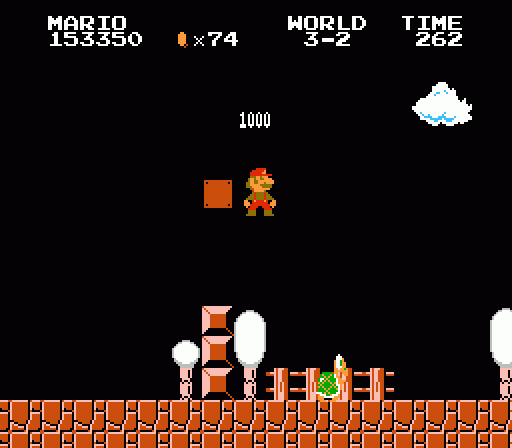
World 3-2
I love world 3-2, because the entire thing is an elaborate troll. The whole of the stage takes the form of a series of wide-open expanses patrolled by Koopa Troopas and Goombas, with the free areas divided up by narrow columns of blocks, single pipes, and the occasional small pit. It’s a low-challenge stage that offers a small breather after World 3-1’s hazards, and it’s chance to get back to some basics as well. Interestingly, this is the first World x-2 stage not to take place in an underground area, instead simply feeling like an extension of World 3-1.
What’s so trollish about it, you ask? Well, you can essentially divide World 3-2 into four segments, wide portions of ground patrolled by groups of foes. Each of these groups is led by a Koopa Troopa, which you can kick and chase to knock out the subsequent enemies without needing to deal with them individually. And, of course, when you use a Koopa shell to take out consecutive enemies, you activate a point multiplier that eventually culminates in a 1UP.

Naturally, if you’ve figured out this secret, you’ll want to rack up as many 1UPs as possible here. Unfortunately, that’s more difficult than it seems. Each of the segments comes up just a little short in terms of enemies to knock out, so your multiplier will almost (but not quite) hit the 1UP every time. Instead, the kicked shell will hit a wall or pipe before chalking up enough kills and rebound back at you — and if you’re not expecting the rebound, it’ll plow right into Mario on its return.
The one exception to this exercise in tantalization comes with the third segment of enemies, which is populated just enough to allow a 1UP. But even that’s not a given, as the lead Koopa walks into a pit almost immediately after he scrolls onto the screen. Worse, when he first appears, there’s a narrow pillar of ground surrounded by pits on either side standing between you and the Koopa. On the pillar is a short pile of block with a low-hanging brick above it. In order to earn this 1UP opportunity, you need to jump over the pit, make a small hop through the narrow space beneath the brick, leap a second pit, and squash the Koopa.
You have about three seconds to do this, so there’s very little room for error. If you can pull it off, though, you’ll enjoy a hard-earned 1UP for your efforts. Remember back when Super Mario games treated 1UPs as precious commodities to be sought at great risk?

(Alternately, you can grab the Starman and totally squander the opportunity.)
World 3-3
The third portion of World 3 returns to the “sky mushroom” style of World 1-3. This time, however, the moving platforms take on a different form. Rather than moving independently on their own time, they instead operate on gravity. They’re remain motionless until Mario jumps on them, at which point they quickly plummet. Like Mario’s jump, there’s an acceleration curve on their movement, so they drop slowly at first but steadily gain speed for as long as you stand on them.
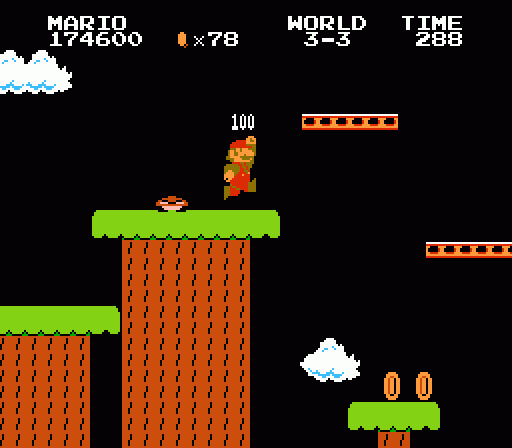
The gravity platforms take two forms: Standalone and pulleyed. A standalone platform is as its name suggests: It’s simply a single moving platform that gives way under Mario’s weight. You’ll need to traverse it and jump off the other side before it plummets off the screen.
Pulleyed platforms, on the other hand, behave somewhat differently. They’re attached to one another by a cable strung across two pivots. When one platform drops, the other rises. You can effectively create your own advantages with this mechanism, riding one platform until the other comes up high enough to give you an easier leap to solid ground. These devices aren’t without their own hazards, though; the cable connector doesn’t hold the platforms as securely as you might expect, so if you let one of them descend too far it’ll snap and fall freely. Worse, the counterbalance platform will rise to the top of the pulley and break free when it hits the fulcrum, dropping as well.
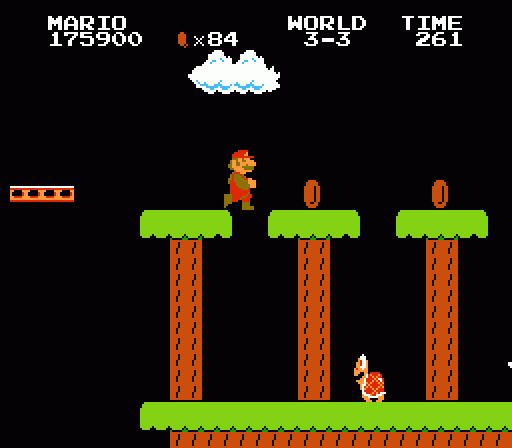
The pulley platforms are really designed to be dashed across. If you land on one at a run and dart immediately to the opposite edge and jump again, you’ll be perfectly safe and have no trouble reaching the second platform or the ground beyond. It’s he who hesitates who becomes lost; if you dawdle or second-guess yourself on the platforms, you’ll almost certainly lose both your momentum and your footing, allowing the pulley to snap and send Mario to his death.
The game waits until this point to introduce pulleys not only because they’re a more complex iteration of a device you’ve seen before, but because it expects you to have the confidence to use them properly at this point. It could have introduced pulleys and free-falling platforms way back in World 1-3, but those were still the “learning” stages of the game. But World 3-3 is the 11th stage of 32; you’re now one-third of the way through Super Mario Bros. By now, you should have a firm sense of the controls and mechanics. Maybe not mastery, but certainly enough of an instinct to know what to do in a situation.

And so, the game throws in a new element that demands you move with confidence… but at the same time, it builds on what has come before and introduces this new addition to the world in a way that allows a little trial-and-error. After all, you’ve already encountered the plummeting freestanding platforms if you’ve found the bonus cloud areas, where they first appeared with an effective safety net. When you encounter a motionless “moving” platform here for the first time, you should know exactly what it’s about — and when you encounter two linked together a short time later, its behavior won’t catch you off guard, either.
World 3-4
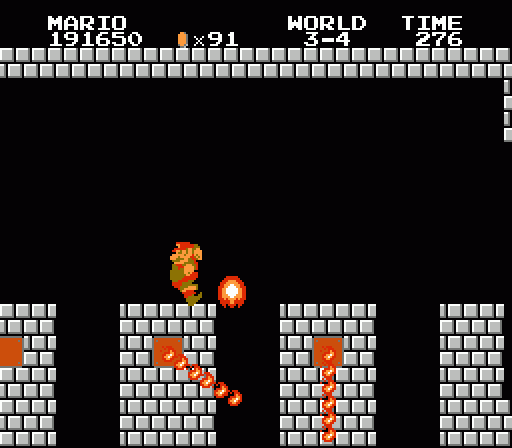
Another short and not entirely stressful castle stage; in fact, this one may be easier than World 2-4. Still, within its brief span, it combines the individual threats of the two previous castles into combined hazards, forcing you to deal simultaneously with the Podoboo fireballs at the same time as either the spinning fire bars or Bowser’s gouts of flame. Again, these are essentially passive dangers that operate on their own timers, so success here ultimately comes down to getting a feel for the timing and not rushing ahead too quickly.
The stage opens with a series of small pits breaking up a number of even columns. Near the upper portion of each column, a fire bar spins, while Podoboos leap into the air from the bottoms of the pits. The fireballs operate on a fairly slow timer, popping up every two revolutions of the fire bars. Once you jump over the first pit, your footing becomes slightly treacherous as the fire bar beneath you will eventually swing around to where you’re standing. Still, you have ample time to make each leap before the bar hits you, and it’s low enough that you can leap over it by jumping straight up at the last second to buy yourself some more time.
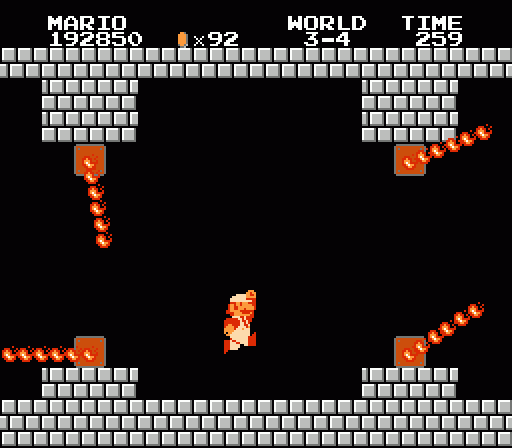
Beyond the pits, the double fire bars from World 2-4 make a reappearance: One spinning above you, one at ground level. As before, the first two sets of fire bars rotate clockwise, so they’re moving in the same direction as Mario — you have a wide window of time to make your jump. The third set, however, rotates counterclockwise; not only that, but they’re staggered somewhat, shortening the window of opportunity even more. Once again, though, the level design is your guide: A trio of coins hovers just to the right of the upper fire bar, and if you aim for these coins once the upper bar moves past, you’ll neatly clear the lower bar and land safely.
The final sequence should be familiar: Gouts of flame traverse the screen, right to left, as you make the approach to Bowser. This time, however, you need to duck them while also leaping over Podoboo pits, one of which works on a much shorter timer. Patience wins the day here, as eventually you’ll have an opening in which you’re flame-free as the Podoboos fall. Beyond them is the usual pit in the floor, though here it’s not really a safe haven as in the past: It’s only a couple of bricks wide, so you can’t really press forward beneath the range of Bowser’s fire.
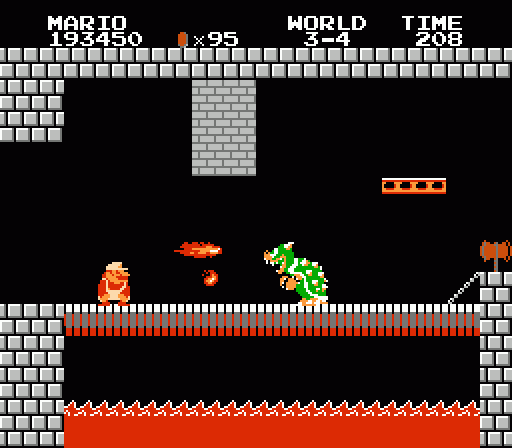
Once again, Bowser (or rather, his proxy) waits at the end of the stage over a bridge. This chamber is shorter than the earlier ones, and another low brick outcropping blocks most of the ceiling. You can squeeze in a jump between the bricks and Bowser to land on the moving platform above him, but this feat clearly is becoming trickier each time.
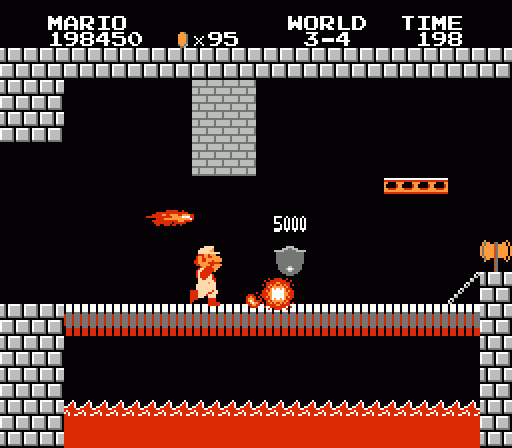
Should you manage to best Bowser with a Fire Flower, he’ll turn into… hmm, weird. What is that round grey thing, anyway?
That’s a Buzzy Beetle shell.
@Dan Yes, we all know, Jeremy’s just pointing out that it would be odd if a first-time player saw it, because Buzzy Beetles haven’t appeared in the game proper yet.
It’s Pumbloom!
It looks like Dan and Kirin already got to my first two reactions. I suppose, however, that if someone had discovered the warp zone in 1-2 and gone straight to world 4, they’d recognize that thing. I’m pretty sure I warped ahead before I mustered up the skill to fireball the third Bowser… but I’m not here to kill the original point, which is well-taken.
I was thinking, for some reason, that the non-pulleyed motionless platforms didn’t accelerate smoothly. It’s probably the only object in the game that moves in such an abrupt manner, but even then, it’s in reaction to what the player does - certainly a far cry better-conceived than the erratic enemy patterns and janky physics of so many other NES platformers.
“Remember back when Super Mario games treated 1UPs as precious commodities to be sought at great risk?”
Yeah, I remember. Nowadays they’re only treated as ways to sell lots of T-shirts and hats.
As much as I like the game, Super Mario Bros. 3 was the beginning of the end for 1UP value.* Assuming you don’t use the two warp whistles to go straight to World 8, the game showers you with 1UP opportunities throughout. You get 1UPs from collecting three cards from the numbered stages, and a run and jump at the goal with the right momentum and timing is usually an ensured Starman card for a potential 5UP. You can win 1UPs from the scrolling picture games (if you don’t suck at them). You can earn a 1UP from the card matching game you get to play every few levels, as well as coins. There’s plenty of coin and 1UP opportunities throughout the stages, especially for power-up savvy players. You might even spawn the coin ship if you’re lucky.
When games like Super Mario World, Yoshi’s Island, and the 3D Marios had 1UPs alongside save data, they attempted to give 1UPs more value by not saving 1UP totals, but it’s really a forced, artificial value. While SMW would take away any stage progress since your last save if you got Game Over, you could just rush through a Ghost House or (if you know the code) an old fortress to save the game, or seek out generous 1UP opportunities elsewhere. While you do lose checkpoint progress, death in the 3D Marios is more an annoyance than a punishment, especially in Super Mario 64 where only a select few stages have checkpoints at all.
More recently, given New Super Mario Bros. 2 hands out enough coins to make Wario and Scrooge McDuck combined green with envy, it makes me wonder why the game designers even bothered locking away the (permanent) saving option at all.
* While Super Mario Bros. 2 (The Doki Doki one) did have the slots, it took luck and timing to get anything of worth from it and not all stages are as generous with produce patches for coins for slot attempts as the likes of 1-2 and 7-1 were.